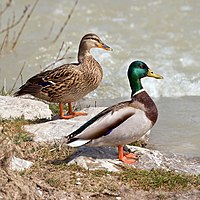
Photo from wikipedia
More than three million farmed mallards are released annually for hunting purposes in Europe. The ecological impact of these releases depends on how many birds survive to join the wild… Click to show full abstract
More than three million farmed mallards are released annually for hunting purposes in Europe. The ecological impact of these releases depends on how many birds survive to join the wild breeding population. We estimated annual survival in farmed-released and wild-caught Swedish mallards, using mark-recapture data. In 2011–2018, we ringed 13,533 farmed ducklings before release (26.5% recovered). Most recoveries were birds shot at the release site, while only about 4% were found >3 km away. In 2002–2018, 19,820 wild mallards were ringed in Sweden, yielding 1369 (6.9%) recoveries. Like in farmed-released birds, most recoveries were by hunting, but 91.1% of recovered wild mallards were >3 km away from the ringing site. Annual survival rate in farmed-released mallards (ringed as pulli) was 0.02. In wild mallards (ringed as fledged or fully grown), annual survival was lower in females (0.64) than in males (0.71). At two sites in 2018, farmed ducklings were released in two batches 3 weeks apart to study the effect of early versus late release date, while controlling for body condition (BCI). Ducklings released early had a higher BCI and were recovered earlier (lower longevity) than those released late. Individual BCI and longevity were not correlated in recovered ducklings. Based on our estimate of annual survival in farmed-released mallards, a substantial number, i.e., 5000 (95% CI, 3040–6960), join the wild population annually. Despite being fed, a large proportion of released ducklings does not survive until the hunting season. Early releases may maximize pre-hunting survival. Repeated releases may prolong hunting opportunities and increase hunting bags.
Journal Title: European Journal of Wildlife Research
Year Published: 2021
Link to full text (if available)
Share on Social Media: Sign Up to like & get
recommendations!